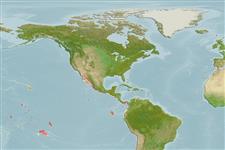Classificação / Names
Nomes comuns | Sinônimos | Catalog of Fishes(Gênero, Espécies) | ITIS | CoL | WoRMS | Cloffa
>
Blenniiformes (Blennies) >
Dactyloscopidae (Sand stargazers)
Etymology: Myxodagnus: Greek, myxos = mucus + Greek, agnos = pure (Ref. 45335); walkeri: Named after Boyd W. Walker in recognition of his fieldwork which produced much of the present material and many other eastern Pacific dactyloscopids (Ref. 39697).
Environment: milieu / climate zone / depth range / distribution range
Ecologia
marinhas demersal; intervalo de profundidade 0 - 6 m (Ref. 39697). Tropical
Distribuição
Países | Áreas da FAO | Ecossistemas | Ocorrências | Point map | Introduções | Faunafri
Eastern Central Pacific: Nayarit, Mexico and Golfo de Nicoya, Costa Rica.
Tamanho / Peso / Idade
Maturity: Lm ? range ? - ? cm
Max length : 5.5 cm SL macho/indeterminado; (Ref. 39697)
Descrição suscinta
Chaves de identificação | Morfologia | Morfometria
Espinhos dorsais (total) : 8 - 10; Raios dorsais (total) : 28 - 31; Raios anais : 33 - 38. Preorbital length longer than diameter of pigmented eye; upper lip fimbriae usually 10-11; modally 2 pores in 1st preopercular canal; dorsum of head mainly speckled with small brown spots, without large blotches or spots; without a distinct suborbital bar or prominent blotches on lower jaw (Ref. 39697).
Ciclo de vida ou comportamento de acasalamento
Maturities | Reprodução | Spawnings | Egg(s) | Fecundities | Larvas
Dawson, C.E., 1976. Studies on eastern Pacific sand stargazers 3. Dactylagnus and Myxodagnus, with description of a new species and subspecies. Copeia 1976(1):13-43. (Ref. 39697)
Status na Lista Vermelha da UICN (Ref. 130435)
Ameaça para os humanos
Harmless
Uso pelos humanos
Ferramentas
Relatórios especiais
Baixar XML
Fontes da internet
Estimates based on models
Índice de diversidade filogenética (Ref.
82804): PD
50 = 0.5312 [Uniqueness, from 0.5 = low to 2.0 = high].
Bayesian length-weight: a=0.01000 (0.00244 - 0.04107), b=3.04 (2.81 - 3.27), in cm total length, based on all LWR estimates for this body shape (Ref.
93245).
Nível Trófico (Ref.
69278): 4.3 ±0.6 se; based on size and trophs of closest relatives
Fishing Vulnerability (Ref.
59153): Low vulnerability (10 of 100).
